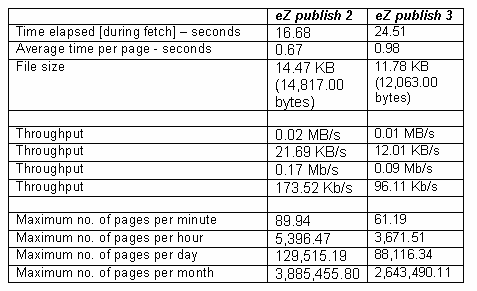eZ publish 2 is one of the most popular open content management systems on the Web today. Its successor, eZ publish 3, is a content management system and development framework that differs fundamentally from version 2.
At present, there is no way to update automatically from version 2 to version 3, although eZ Systems has planned to release an upgrade script. Until then, a user’s decision to adopt either version 2 or 3 will have far-reaching implications for the future development of their Website.
eZ publish 2 is a stable, well-tested system, but development of version 2 might be discontinued in the future. At the moment, eZ Systems does still support this version, but with limited resources. The development of eZ publish version 3 is in full swing, and offers all the associated advantages and disadvantages to its early adopters. Version 3 is high-maintenance because it contains more bugs and offers less ‘out-of-the-box’ functionality than did the previous version, but it offers more opportunities for the future development of a site.
This report provides a general framework that will allow the reader to make an informed choice between the 2 versions of the eZ publish CMS. It doesn’t attempt to establish which of the versions should be considered the ‘preferred option’. The suitability of either version will depend on the functional requirements of a site, plans for its future development and the time/project constraints experienced by the developer.
About eZ publish
eZ publish, a CMS released under an open source licence, has recently become very popular. The system includes all the features of most commercially licensed systems and offers many optional extras. The eZ publish CMS has been developed by eZ systems, a small company located in Skien, Norway (visit their site for more information).
eZ publish 2.2.x is a professional open source CMS that gives easy access to Internet sites through a user-friendly and reliable program. It is platform- and database-independent, and module based, with a total of 26 different modules available. Version 2 was first released in November 2000; the most recent version of the 2 series is 2.2.8.
eZ publish 3 is a content management system and development framework. The CMS is based on a fully customizable and extendable content model. Its stand-alone libraries can be used as a development framework for cross-platform, database-independent PHP projects. Version 3 was released on 25 March 2003. The first update of version 3 has already been released (3.0-2), which fixed some bugs that had been found in the kernel.
As the numbering of versions suggests, there are some fundamental differences between eZ publish versions 2 and 3. eZ publish 3 broadens the capabilities of version 2 towards a general application framework, providing basic data handling and display mechanisms and expanding indefinitely the possibilities for creating customized content within the system.
Whereas version 2 works with a ‘limited’ set of 26 modules, version 3 allows users to identify their own content classes and attributes. Some examples of content classes are:
- article
- forum
- product
- publication
- organization
- user account
A simple ‘article’ content class may consist of attributes such as author, title, intro and body. New classes and attributes can be simply added through the administrative back end — no additional coding is required.
Evaluation criteria
For the purposes of this investigation, the 2 versions of eZ publish were evaluated on the basis of the following criteria:
- functionality
- flexibility
- performance
- stability
Usability was not included as a criterion because both the front- and back-end of the eZ publish application can be fully customized to meet the needs of users and content managers.
Functionality
The bigger the gap between functional requirements and actual functionality available in the default install of eZ publish, the more resources (staff, money and time) the user will have to expend on site development. In the best case scenario, customization is limited to the enhancement of the design or existing functionality. In the worst case, advanced customization requires the development of new functionality from scratch.
Advanced but poorly documented customization may turn the eZ publish system into a legacy solution that no one can extend, extract data from, or fix bugs on. Once the system is no longer truly ‘open’, the organization may be tied into an exclusive, long-term contract with the company that customized the system. Moreover, advanced customization may seriously hamper the installation of future updates, with the result that the organization could miss out on important security updates.
eZ publish 2 is a system with extensive built-in functionality that meets the needs of most small to medium-sized organizations and campaigns. The customization of existing modules is usually limited to adapting and improving eZ Article (multiple topics, alternative links, additional frontpage rows), eZ Filemanager (sorting method), eZ Search (searching additional modules) and eZ Link (sorting method). In many cases, customization also involves adding extra fields for information to a module. For example, in the case of eZ Filemanager this could be the field ‘author’ for a file. More advanced customization is often required for multilingual support, eZ Calendar, eZ Contact, or in cases where eZ Filemanager has to be converted into an ‘elibrary’.
At first glance, eZ publish 3 appears to offer much less functionality than version 2. However, as mentioned above, version 3 allows users to identify their own content classes and attributes through the administrative back end. Much of the functionality of the version 2 modules is available in some form in version 3 (see this article for more). A number of standard functional enhancements required for version 2 are available by default in version 3, and additional information fields (attributes) can be added to objects without coding. This means that it’s possible to implement advanced customization of version 3 while keeping the source code comprehensible or ‘open’, thus avoiding dependency upon a single service provider.
Version 3 has a compact design and the kernel does not need to be altered for most customizations. As a result, future upgrades are possible even if the system is highly customized. Moreover, eZ Systems is working on additional example implementations in version 3, and making it easier for others to contribute their work.
Conclusion
eZ publish 2 offers more in terms of ‘out-of-the-box’ functionality, allowing organizations with limited resources and time constraints to ‘jump start’ their Internet projects while keeping costs under control. Version 2 is flexible enough to allow functional extensions as and when they’re required, but advanced development of this system may lead to dependency on an external service provider for technical maintenance.
eZ publish 3 is ideally suited for projects that require functionality beyond that provided in the ‘standard’ modules. It allows for extensive customization, while avoiding external dependency. However, due to its flexibility, the lack of accurate and comprehensive functional specifications may cause the development process to spiral out of control. This ‘grown up’ system needs a ‘grown up’ development approach, which might not suit time- and resource-pressed organizations.
Flexibility
The flexibility of eZ publish versions 2 and 3 was compared in terms of the creation of custom content classes and page customization and layout. With regard to custom content classes, as mentioned above, eZ publish 3 allows users to identify their own content classes and attributes through the administrative back-end. In version 2 this required making manual changes to the database, coding new classes and functions and creating the matching front- and back-end templates.
In eZ publish, page customization and layout are separated from content, code, and multilingual functionality. Every page is generated dynamically, by means of a template. A template is one or more plain HTML files that contain template variables. These variables are filled in by eZ publish when a page is generated. In eZ publish 2, the template sets are spread among all modules. Each module has at least a subdirectory called ‘admin’ and usually a directory called ‘user’.
In eZ publish 3, all standard templates are stored in a single folder. The basic principle for creating custom designs in version 3 is to create within the custom design folders override templates that replace the standard templates. eZ publish 3 also introduces template operators and functions that allow advanced template customization.
Conclusion
The creation of new content classes and attributes is much easier in version 3 than it is in version 2. One of the advantages of Version 3 is that it allows users to identify their own content classes and attributes without coding or manual database updates. The only task that remains is to develop the necessary front-end templates for the new content class.
In version 3, the template system has become more advanced and flexible, but it’s also more cumbersome to implement. In comparison to version 2, the version 3 user needs to have a greater knowledge of the eZ publish application in order to be able to set up or change design templates. This could lead to a situation where an organization could become dependent on an external service provider for even minor changes to the look and feel of its site.
Performance
Scalability and performance are key factors in the evaluation of any Web platform. In this evaluation, eZ httpbench was used to gain an indication of the differences in the performance of eZ publish versions 2 and 3. The experiences of users as submitted to the forums on the eZ publish Website were also reviewed.
Using eZ httpbench, a tool developed by eZ Systems to benchmark HTTP pages, the average download times of pages with a size of approximately 12.0 KB were compared for the 2 versions. The following pages were fetched 25 times by the eZ httpbench benchmark tool (14.47 KB, eZ publish 2 and 11.78 KB, eZ publish 3). The results are shown in table 1 below. Unfortunately, eZ httpbench is no longer available as a download from the eZ Systems site, but it can still be downloaded here.
Note that these statistics are not typical for all installs of eZ publish. Throughput may vary according to server specifications, the overall server load, the configuration of the eZ publish application, and the use of accelerators. The results of a more extensive performance test of eZ publish version 3 are available on the eZ publish site.
Table 1. Comparison of eZ publish versions 2 and 3: average download times of pages with a size of approximately 12.0 KB

On the eZ publish Website’s developer forums, users report mixed experiences with regard to the performance of versions 2 and 3. Some users find that version 2 performs better, while others prefer version 3. The use of eZ publish caching and PHP caching applications has recently received a lot of attention, and useful suggestions have been made on how to use caching to improve performance.
According to one forum post from an eZ publish developer, ‘[…] we’ve just started with optimizations and you should see tremendous speed improvements from the 2.x series’. Another experienced user advises others to use ‘2 GHz dual cpu servers + php accelerator for a heavy load eZ publish 3 server’. Users report that both versions contain several poorly written SQL statements that slow down some parts of the application.
eZ Systems claims that eZ publish 3 is much more scalable than version 2. However, because of the flexibility of version 3, it is also easier to misconfigure the system, and thus experience poorer performance. eZ Systems has made this issue a focus point for the future development of version 3. We have not attempted to verify the claim of scalability in this discussion, but for more information on this topic, see this discussion.
Conclusion
From the eZ httpbench tests, it appears that eZ publish 3 is slightly slower than version 2. However, the performance of both versions 2 and 3 on a standard server is still more than adequate. The performance of both versions may be further improved by tuning the site with eZ publish caching enabled, or by using PHP caching applications, such as the ionCube PHP Accelerator, Zend, Alternativ PHP Cache or Turck MMCache.
Stability
For the purposes of this evaluation, ‘stability’ is defined as the number of bugs reported over a fixed period of time. This basically means: the smaller the number of bugs, the more stable the system is considered. Obviously, this working definition can be said to measure other things besides ‘stability’, such as the commitment or involvement of the user community to one particular version, or the degree to which the available functionality matches the users’ expectations or requirements.
In any case, it is safe to say that a system with a large number of reported bugs will require more maintenance than one with fewer reported bugs. If an organization does not have the resources to monitor developments and perform all the required updates, an advanced system may soon develop into a slow, unreliable, error-ridden and potentially insecure Website.
Overviews of the eZ publish bugs can be found here and here. Table 2 below lists the numbers of bugs reported during the period 26 March to 26 May 2003, categorized as follows: database, user interface, generic logic problems, permissions, hangs and crashes, and other. Bugs that presented security problems are also listed.
Table 2. Comparison of eZ publish versions 2 and 3: numbers of bugs in each category reported during the period 26 March to 26 May 2003

Conclusion
eZ publish 2 is an application that requires relatively little maintenance. The system is well-tested, stable and apparently secure. An organization opting for an eZ publish 2 application with fairly limited customization would be relatively independent from external developers.
Although eZ publish 3 has an advantage over version 2 in that it expands the possibilities for the creation of customized content within the system, it is still a high-maintenance application. Though the core functionality of version 3 is much more stable than version 2, the number of bugs in version 3 is still considerable. Vigilance on the part of the internal IT team or the external developers is constantly required, at least to ensure that all potential (security) problems are resolved. However, a systematic approach with regard to the handling of bugs might be beyond the scope of organizations with limited resources.
The Results
In general, we’d advise any organization to be realistic and use common sense when developing an Internet strategy. The organization should take into account its current requirements and future plans for a Website, the availability of resources (budget, staff, developers, support), and possible time constraints. For example, do the functional requirements demand the use of the latest, cutting-edge Web-based technology, or does the organization simply need something to ‘jump start’ an Internet project, while keeping other options open?
eZ publish 2 is an ideal solution for an organization with limited resources and time, which requires a low-maintenance, user-friendly application with extensive ‘out-of-the-box’ functionality. The server requirements for running version 2 are relatively modest, and enable the organization to opt for a cheap hosting solution. eZ publish 2 has a comprehensive set of functional modules that require little modification to meet the demands of most small to medium-sized organizations.
The back-end is user-friendly and easy to understand, even for novices with no Web publishing experience. Changing the look and feel of the front end is relatively simple, and does not require extensive knowledge of the eZ publish application. Due to its flexible, modular set up, version 2 allows advanced customization to meet the needs of the organization, but this might come at the cost of dependence on an external service provider and problems with the install of (security) updates or modifications by third parties.
eZ publish 3 is ideally suited to organizations whose functional requirements go beyond what is provided in the ‘standard’ modules of version 2, or that have ambitious plans for future site development. eZ publish 3 is more flexible than version 2, and allows for extensive customization while avoiding dependency on a single external service provider. On the downside, the development of a Website based on eZ publish 3 will require more from an organization (or external service provider) in terms of involvement in the development cycle, project planning skills, application maintenance and training of Web designers/developers and content managers than would a site based on version 2.
Because version 3 is more flexible, it has a steeper learning curve than in version 2. This disadvantage is offset by the quality of the available manuals and community-contributed documentation. The performance level of eZ Publish 3 is acceptable, and is likely to improve in the near future, but the use of PHP caching applications could put some restrictions on the choice of hosting accounts.
Sebastiaan is Contactivity’s Technical Director, and is specialized in content management systems, online collaboration tools and Internet information and technology audits.



